RMIT University MKTG1101: Consumer Behavior Article Review Report
VerifiedAdded on 2022/10/01
|7
|1733
|202
Report
AI Summary
This report presents a comprehensive review of four scholarly articles focusing on consumer behavior, as assigned in the MKTG1101 course at RMIT University. The report begins with a 500-word introduction that provides an overview of the chosen topic: consumer as an individual, and outlines the core concepts and themes of the articles. The first article examines consumer motivation and luxury consumption, while the second explores consumer needs in the context of smart clothing design. The third article delves into the role of consumer perspectives in shaping buyer decisions, and the final article investigates the impact of self-concept on subscription choices. Each article is then analyzed in a 250-word review, critically evaluating the authors' arguments, methodologies, and findings. The report adheres to the specified word count and provides a critical perspective on the strengths and weaknesses of the research, its alignment with consumer behavior theory, and its relevance to marketing practices.

Running Head : ARTICLE REVIEW
Article Review
Name of the Student
Name of the University
Author Note
Article Review
Name of the Student
Name of the University
Author Note
Paraphrase This Document
Need a fresh take? Get an instant paraphrase of this document with our AI Paraphraser
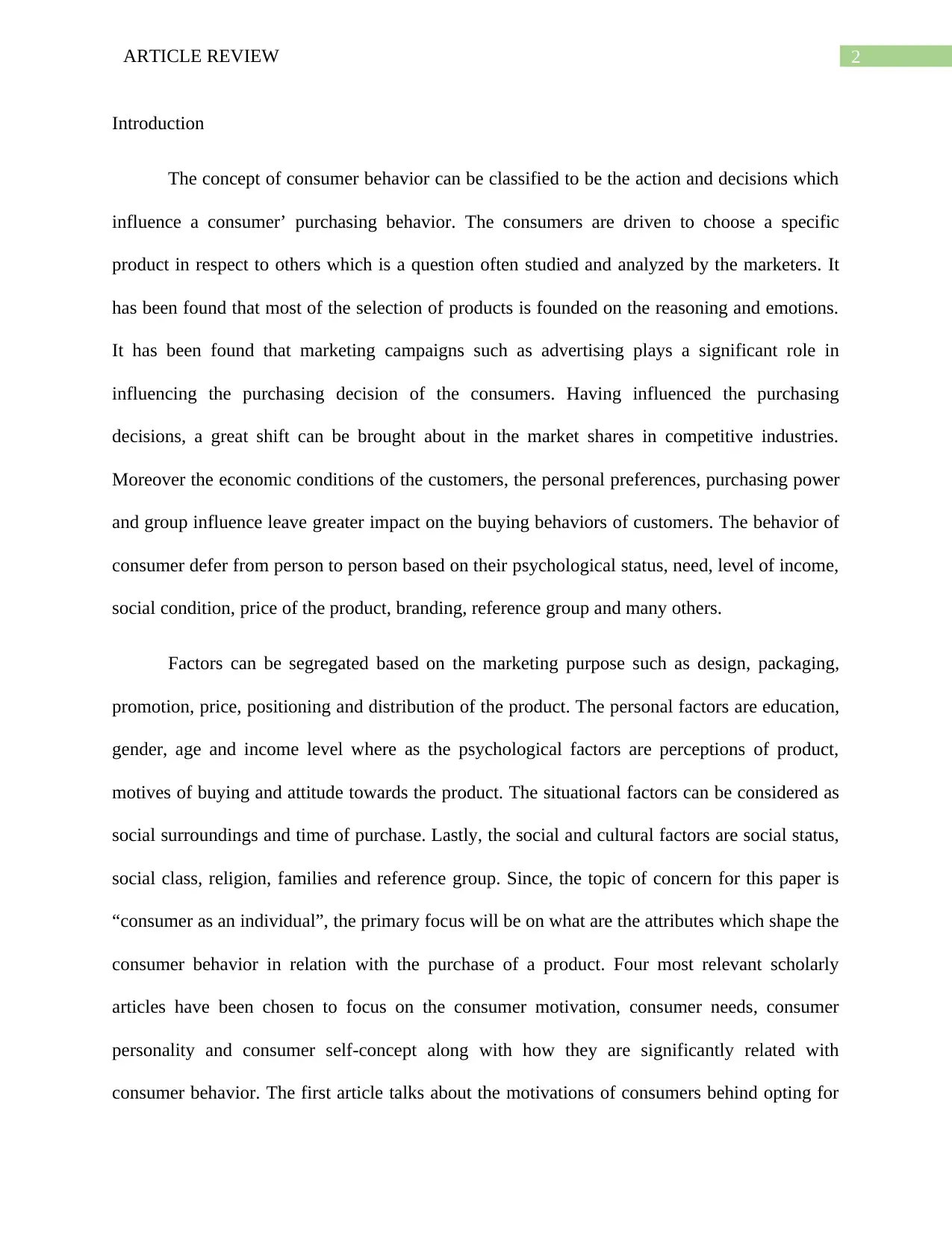
2ARTICLE REVIEW
Introduction
The concept of consumer behavior can be classified to be the action and decisions which
influence a consumer’ purchasing behavior. The consumers are driven to choose a specific
product in respect to others which is a question often studied and analyzed by the marketers. It
has been found that most of the selection of products is founded on the reasoning and emotions.
It has been found that marketing campaigns such as advertising plays a significant role in
influencing the purchasing decision of the consumers. Having influenced the purchasing
decisions, a great shift can be brought about in the market shares in competitive industries.
Moreover the economic conditions of the customers, the personal preferences, purchasing power
and group influence leave greater impact on the buying behaviors of customers. The behavior of
consumer defer from person to person based on their psychological status, need, level of income,
social condition, price of the product, branding, reference group and many others.
Factors can be segregated based on the marketing purpose such as design, packaging,
promotion, price, positioning and distribution of the product. The personal factors are education,
gender, age and income level where as the psychological factors are perceptions of product,
motives of buying and attitude towards the product. The situational factors can be considered as
social surroundings and time of purchase. Lastly, the social and cultural factors are social status,
social class, religion, families and reference group. Since, the topic of concern for this paper is
“consumer as an individual”, the primary focus will be on what are the attributes which shape the
consumer behavior in relation with the purchase of a product. Four most relevant scholarly
articles have been chosen to focus on the consumer motivation, consumer needs, consumer
personality and consumer self-concept along with how they are significantly related with
consumer behavior. The first article talks about the motivations of consumers behind opting for
Introduction
The concept of consumer behavior can be classified to be the action and decisions which
influence a consumer’ purchasing behavior. The consumers are driven to choose a specific
product in respect to others which is a question often studied and analyzed by the marketers. It
has been found that most of the selection of products is founded on the reasoning and emotions.
It has been found that marketing campaigns such as advertising plays a significant role in
influencing the purchasing decision of the consumers. Having influenced the purchasing
decisions, a great shift can be brought about in the market shares in competitive industries.
Moreover the economic conditions of the customers, the personal preferences, purchasing power
and group influence leave greater impact on the buying behaviors of customers. The behavior of
consumer defer from person to person based on their psychological status, need, level of income,
social condition, price of the product, branding, reference group and many others.
Factors can be segregated based on the marketing purpose such as design, packaging,
promotion, price, positioning and distribution of the product. The personal factors are education,
gender, age and income level where as the psychological factors are perceptions of product,
motives of buying and attitude towards the product. The situational factors can be considered as
social surroundings and time of purchase. Lastly, the social and cultural factors are social status,
social class, religion, families and reference group. Since, the topic of concern for this paper is
“consumer as an individual”, the primary focus will be on what are the attributes which shape the
consumer behavior in relation with the purchase of a product. Four most relevant scholarly
articles have been chosen to focus on the consumer motivation, consumer needs, consumer
personality and consumer self-concept along with how they are significantly related with
consumer behavior. The first article talks about the motivations of consumers behind opting for
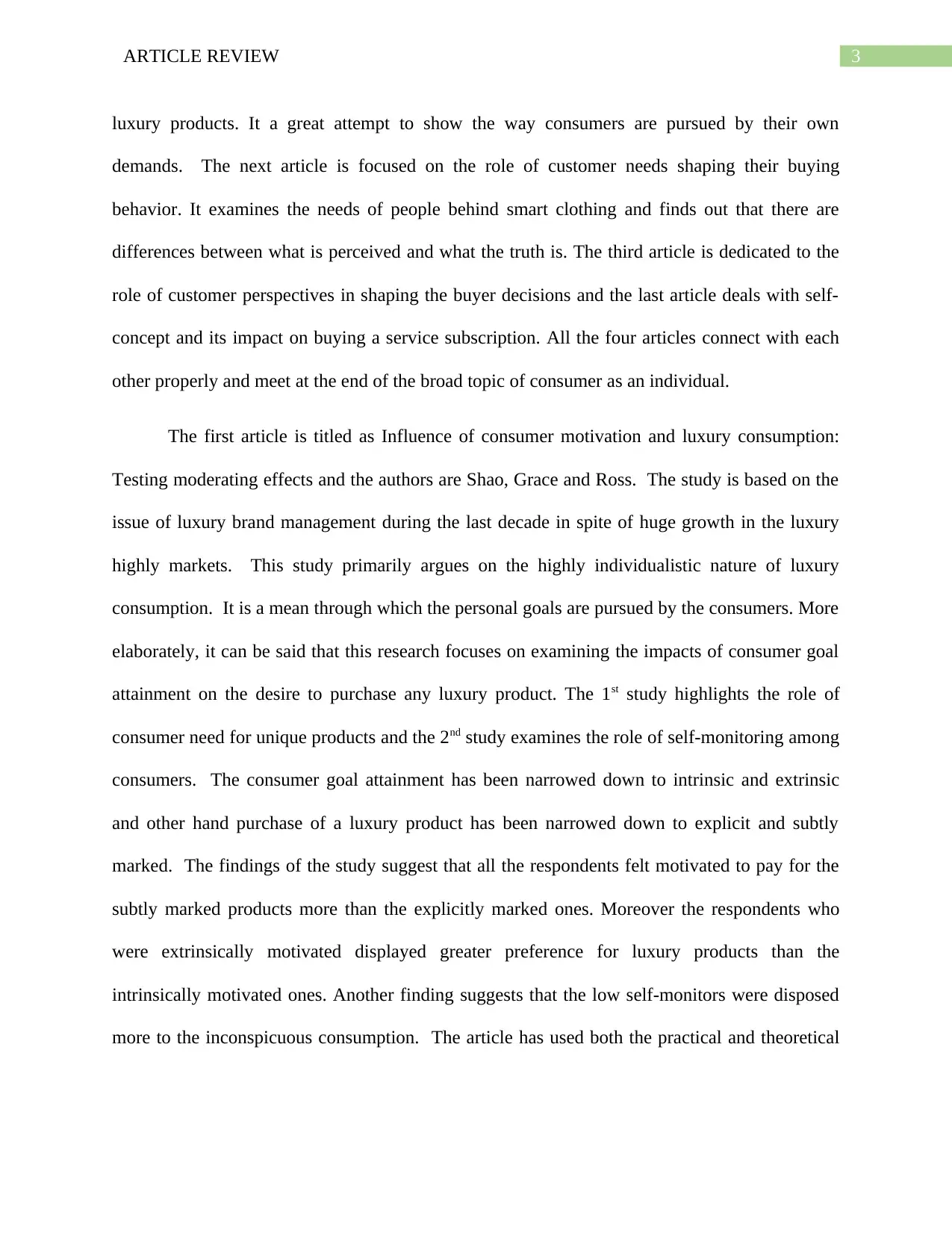
3ARTICLE REVIEW
luxury products. It a great attempt to show the way consumers are pursued by their own
demands. The next article is focused on the role of customer needs shaping their buying
behavior. It examines the needs of people behind smart clothing and finds out that there are
differences between what is perceived and what the truth is. The third article is dedicated to the
role of customer perspectives in shaping the buyer decisions and the last article deals with self-
concept and its impact on buying a service subscription. All the four articles connect with each
other properly and meet at the end of the broad topic of consumer as an individual.
The first article is titled as Influence of consumer motivation and luxury consumption:
Testing moderating effects and the authors are Shao, Grace and Ross. The study is based on the
issue of luxury brand management during the last decade in spite of huge growth in the luxury
highly markets. This study primarily argues on the highly individualistic nature of luxury
consumption. It is a mean through which the personal goals are pursued by the consumers. More
elaborately, it can be said that this research focuses on examining the impacts of consumer goal
attainment on the desire to purchase any luxury product. The 1st study highlights the role of
consumer need for unique products and the 2nd study examines the role of self-monitoring among
consumers. The consumer goal attainment has been narrowed down to intrinsic and extrinsic
and other hand purchase of a luxury product has been narrowed down to explicit and subtly
marked. The findings of the study suggest that all the respondents felt motivated to pay for the
subtly marked products more than the explicitly marked ones. Moreover the respondents who
were extrinsically motivated displayed greater preference for luxury products than the
intrinsically motivated ones. Another finding suggests that the low self-monitors were disposed
more to the inconspicuous consumption. The article has used both the practical and theoretical
luxury products. It a great attempt to show the way consumers are pursued by their own
demands. The next article is focused on the role of customer needs shaping their buying
behavior. It examines the needs of people behind smart clothing and finds out that there are
differences between what is perceived and what the truth is. The third article is dedicated to the
role of customer perspectives in shaping the buyer decisions and the last article deals with self-
concept and its impact on buying a service subscription. All the four articles connect with each
other properly and meet at the end of the broad topic of consumer as an individual.
The first article is titled as Influence of consumer motivation and luxury consumption:
Testing moderating effects and the authors are Shao, Grace and Ross. The study is based on the
issue of luxury brand management during the last decade in spite of huge growth in the luxury
highly markets. This study primarily argues on the highly individualistic nature of luxury
consumption. It is a mean through which the personal goals are pursued by the consumers. More
elaborately, it can be said that this research focuses on examining the impacts of consumer goal
attainment on the desire to purchase any luxury product. The 1st study highlights the role of
consumer need for unique products and the 2nd study examines the role of self-monitoring among
consumers. The consumer goal attainment has been narrowed down to intrinsic and extrinsic
and other hand purchase of a luxury product has been narrowed down to explicit and subtly
marked. The findings of the study suggest that all the respondents felt motivated to pay for the
subtly marked products more than the explicitly marked ones. Moreover the respondents who
were extrinsically motivated displayed greater preference for luxury products than the
intrinsically motivated ones. Another finding suggests that the low self-monitors were disposed
more to the inconspicuous consumption. The article has used both the practical and theoretical
⊘ This is a preview!⊘
Do you want full access?
Subscribe today to unlock all pages.

Trusted by 1+ million students worldwide
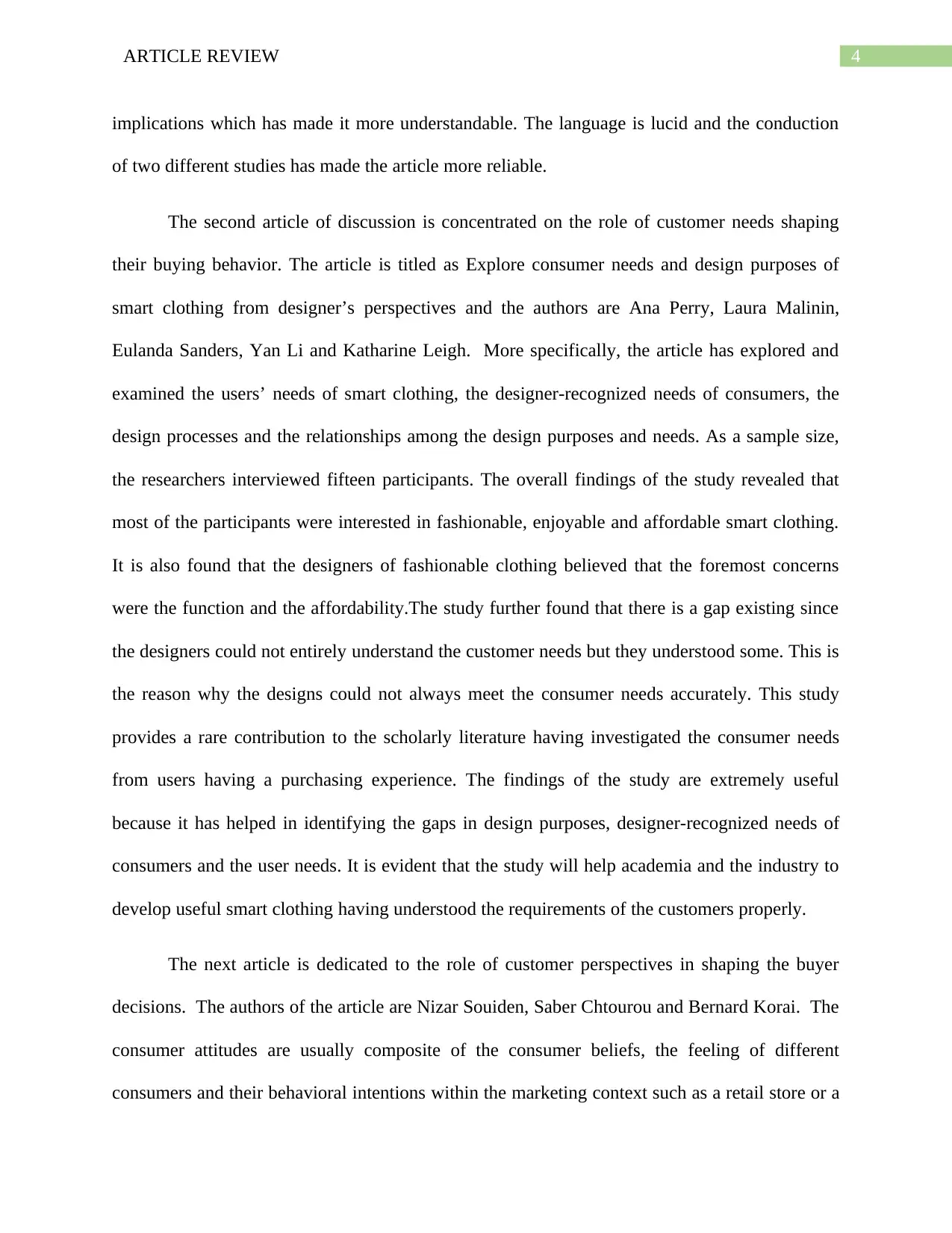
4ARTICLE REVIEW
implications which has made it more understandable. The language is lucid and the conduction
of two different studies has made the article more reliable.
The second article of discussion is concentrated on the role of customer needs shaping
their buying behavior. The article is titled as Explore consumer needs and design purposes of
smart clothing from designer’s perspectives and the authors are Ana Perry, Laura Malinin,
Eulanda Sanders, Yan Li and Katharine Leigh. More specifically, the article has explored and
examined the users’ needs of smart clothing, the designer-recognized needs of consumers, the
design processes and the relationships among the design purposes and needs. As a sample size,
the researchers interviewed fifteen participants. The overall findings of the study revealed that
most of the participants were interested in fashionable, enjoyable and affordable smart clothing.
It is also found that the designers of fashionable clothing believed that the foremost concerns
were the function and the affordability.The study further found that there is a gap existing since
the designers could not entirely understand the customer needs but they understood some. This is
the reason why the designs could not always meet the consumer needs accurately. This study
provides a rare contribution to the scholarly literature having investigated the consumer needs
from users having a purchasing experience. The findings of the study are extremely useful
because it has helped in identifying the gaps in design purposes, designer-recognized needs of
consumers and the user needs. It is evident that the study will help academia and the industry to
develop useful smart clothing having understood the requirements of the customers properly.
The next article is dedicated to the role of customer perspectives in shaping the buyer
decisions. The authors of the article are Nizar Souiden, Saber Chtourou and Bernard Korai. The
consumer attitudes are usually composite of the consumer beliefs, the feeling of different
consumers and their behavioral intentions within the marketing context such as a retail store or a
implications which has made it more understandable. The language is lucid and the conduction
of two different studies has made the article more reliable.
The second article of discussion is concentrated on the role of customer needs shaping
their buying behavior. The article is titled as Explore consumer needs and design purposes of
smart clothing from designer’s perspectives and the authors are Ana Perry, Laura Malinin,
Eulanda Sanders, Yan Li and Katharine Leigh. More specifically, the article has explored and
examined the users’ needs of smart clothing, the designer-recognized needs of consumers, the
design processes and the relationships among the design purposes and needs. As a sample size,
the researchers interviewed fifteen participants. The overall findings of the study revealed that
most of the participants were interested in fashionable, enjoyable and affordable smart clothing.
It is also found that the designers of fashionable clothing believed that the foremost concerns
were the function and the affordability.The study further found that there is a gap existing since
the designers could not entirely understand the customer needs but they understood some. This is
the reason why the designs could not always meet the consumer needs accurately. This study
provides a rare contribution to the scholarly literature having investigated the consumer needs
from users having a purchasing experience. The findings of the study are extremely useful
because it has helped in identifying the gaps in design purposes, designer-recognized needs of
consumers and the user needs. It is evident that the study will help academia and the industry to
develop useful smart clothing having understood the requirements of the customers properly.
The next article is dedicated to the role of customer perspectives in shaping the buyer
decisions. The authors of the article are Nizar Souiden, Saber Chtourou and Bernard Korai. The
consumer attitudes are usually composite of the consumer beliefs, the feeling of different
consumers and their behavioral intentions within the marketing context such as a retail store or a
Paraphrase This Document
Need a fresh take? Get an instant paraphrase of this document with our AI Paraphraser
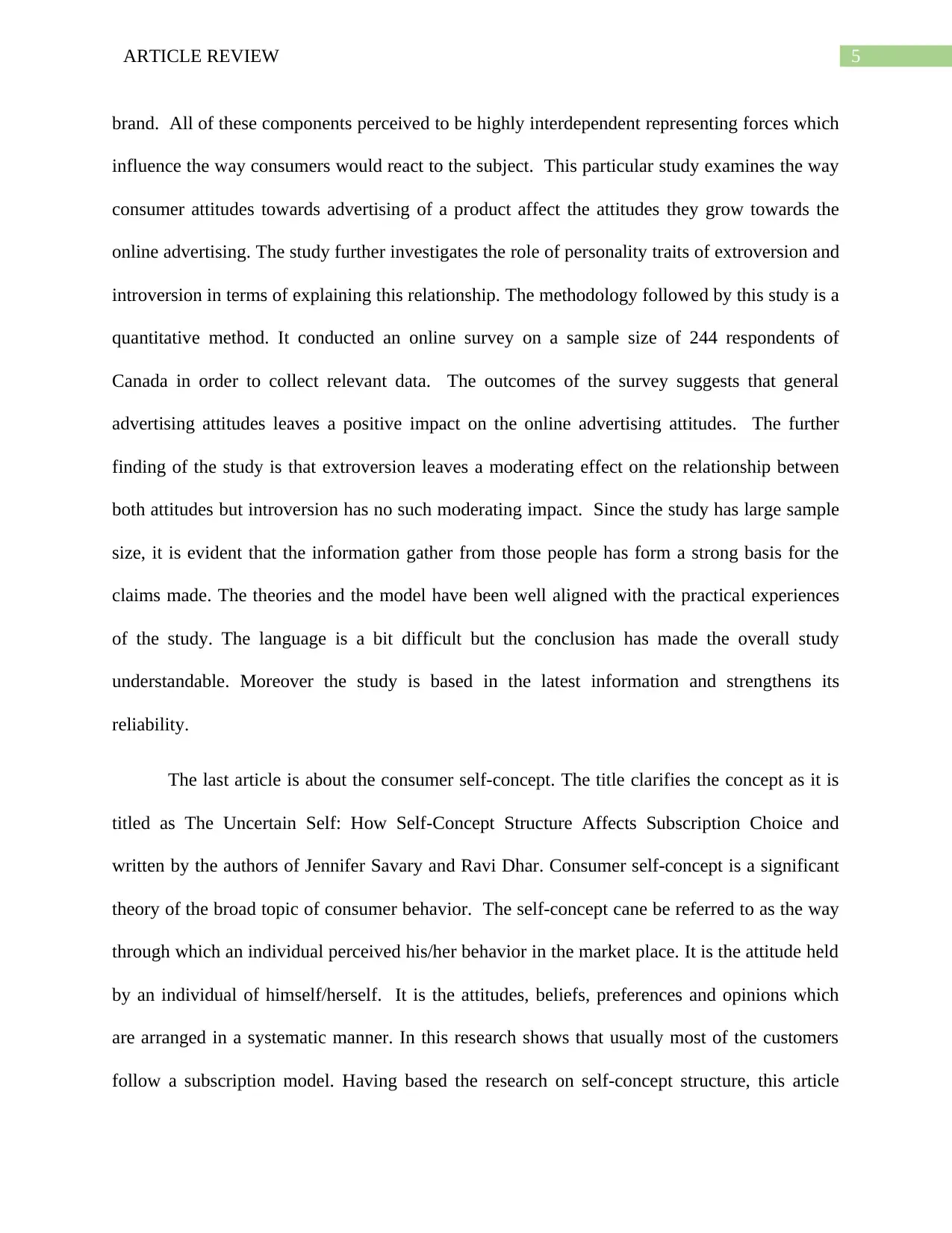
5ARTICLE REVIEW
brand. All of these components perceived to be highly interdependent representing forces which
influence the way consumers would react to the subject. This particular study examines the way
consumer attitudes towards advertising of a product affect the attitudes they grow towards the
online advertising. The study further investigates the role of personality traits of extroversion and
introversion in terms of explaining this relationship. The methodology followed by this study is a
quantitative method. It conducted an online survey on a sample size of 244 respondents of
Canada in order to collect relevant data. The outcomes of the survey suggests that general
advertising attitudes leaves a positive impact on the online advertising attitudes. The further
finding of the study is that extroversion leaves a moderating effect on the relationship between
both attitudes but introversion has no such moderating impact. Since the study has large sample
size, it is evident that the information gather from those people has form a strong basis for the
claims made. The theories and the model have been well aligned with the practical experiences
of the study. The language is a bit difficult but the conclusion has made the overall study
understandable. Moreover the study is based in the latest information and strengthens its
reliability.
The last article is about the consumer self-concept. The title clarifies the concept as it is
titled as The Uncertain Self: How Self-Concept Structure Affects Subscription Choice and
written by the authors of Jennifer Savary and Ravi Dhar. Consumer self-concept is a significant
theory of the broad topic of consumer behavior. The self-concept cane be referred to as the way
through which an individual perceived his/her behavior in the market place. It is the attitude held
by an individual of himself/herself. It is the attitudes, beliefs, preferences and opinions which
are arranged in a systematic manner. In this research shows that usually most of the customers
follow a subscription model. Having based the research on self-concept structure, this article
brand. All of these components perceived to be highly interdependent representing forces which
influence the way consumers would react to the subject. This particular study examines the way
consumer attitudes towards advertising of a product affect the attitudes they grow towards the
online advertising. The study further investigates the role of personality traits of extroversion and
introversion in terms of explaining this relationship. The methodology followed by this study is a
quantitative method. It conducted an online survey on a sample size of 244 respondents of
Canada in order to collect relevant data. The outcomes of the survey suggests that general
advertising attitudes leaves a positive impact on the online advertising attitudes. The further
finding of the study is that extroversion leaves a moderating effect on the relationship between
both attitudes but introversion has no such moderating impact. Since the study has large sample
size, it is evident that the information gather from those people has form a strong basis for the
claims made. The theories and the model have been well aligned with the practical experiences
of the study. The language is a bit difficult but the conclusion has made the overall study
understandable. Moreover the study is based in the latest information and strengthens its
reliability.
The last article is about the consumer self-concept. The title clarifies the concept as it is
titled as The Uncertain Self: How Self-Concept Structure Affects Subscription Choice and
written by the authors of Jennifer Savary and Ravi Dhar. Consumer self-concept is a significant
theory of the broad topic of consumer behavior. The self-concept cane be referred to as the way
through which an individual perceived his/her behavior in the market place. It is the attitude held
by an individual of himself/herself. It is the attitudes, beliefs, preferences and opinions which
are arranged in a systematic manner. In this research shows that usually most of the customers
follow a subscription model. Having based the research on self-concept structure, this article
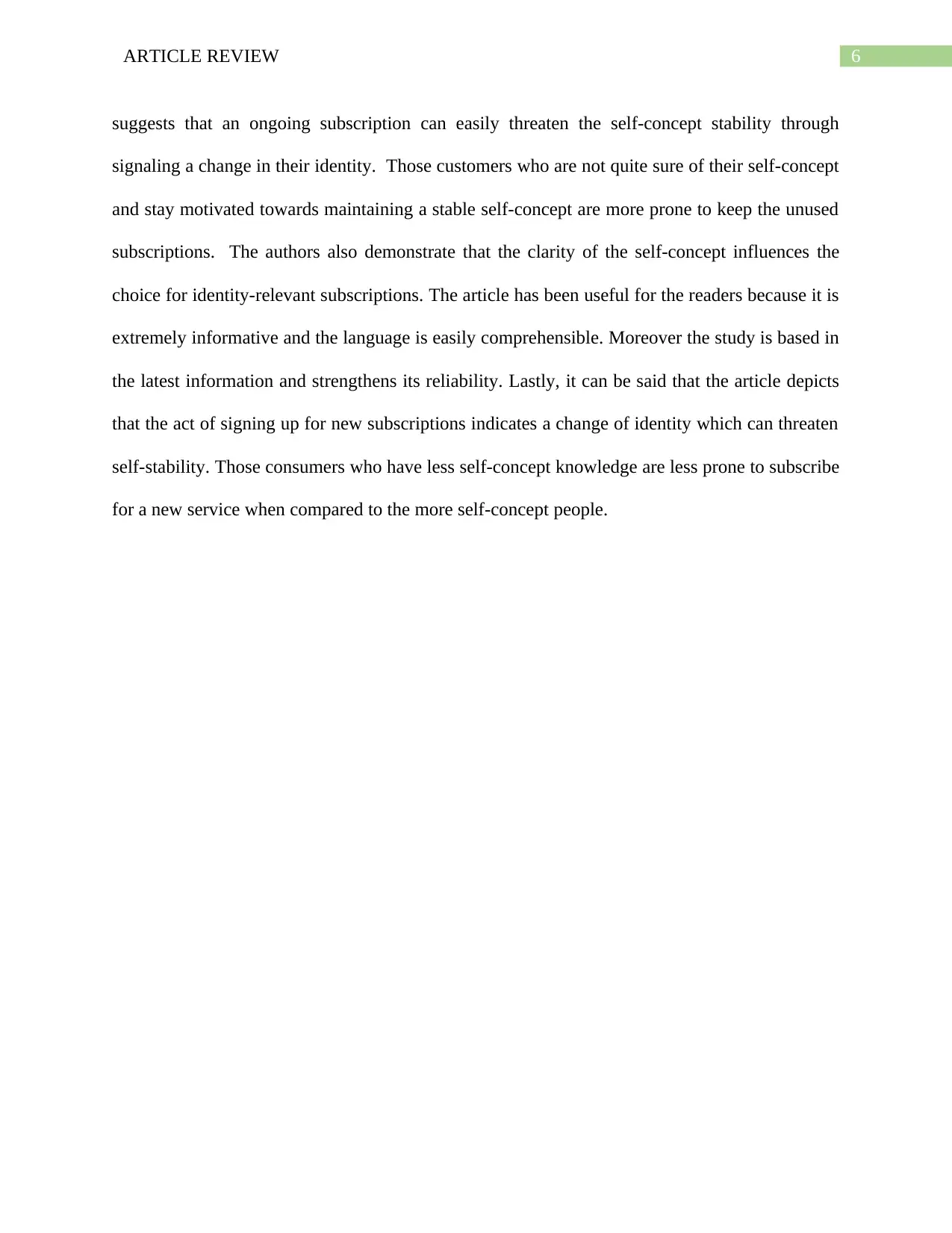
6ARTICLE REVIEW
suggests that an ongoing subscription can easily threaten the self-concept stability through
signaling a change in their identity. Those customers who are not quite sure of their self-concept
and stay motivated towards maintaining a stable self-concept are more prone to keep the unused
subscriptions. The authors also demonstrate that the clarity of the self-concept influences the
choice for identity-relevant subscriptions. The article has been useful for the readers because it is
extremely informative and the language is easily comprehensible. Moreover the study is based in
the latest information and strengthens its reliability. Lastly, it can be said that the article depicts
that the act of signing up for new subscriptions indicates a change of identity which can threaten
self-stability. Those consumers who have less self-concept knowledge are less prone to subscribe
for a new service when compared to the more self-concept people.
suggests that an ongoing subscription can easily threaten the self-concept stability through
signaling a change in their identity. Those customers who are not quite sure of their self-concept
and stay motivated towards maintaining a stable self-concept are more prone to keep the unused
subscriptions. The authors also demonstrate that the clarity of the self-concept influences the
choice for identity-relevant subscriptions. The article has been useful for the readers because it is
extremely informative and the language is easily comprehensible. Moreover the study is based in
the latest information and strengthens its reliability. Lastly, it can be said that the article depicts
that the act of signing up for new subscriptions indicates a change of identity which can threaten
self-stability. Those consumers who have less self-concept knowledge are less prone to subscribe
for a new service when compared to the more self-concept people.
⊘ This is a preview!⊘
Do you want full access?
Subscribe today to unlock all pages.

Trusted by 1+ million students worldwide
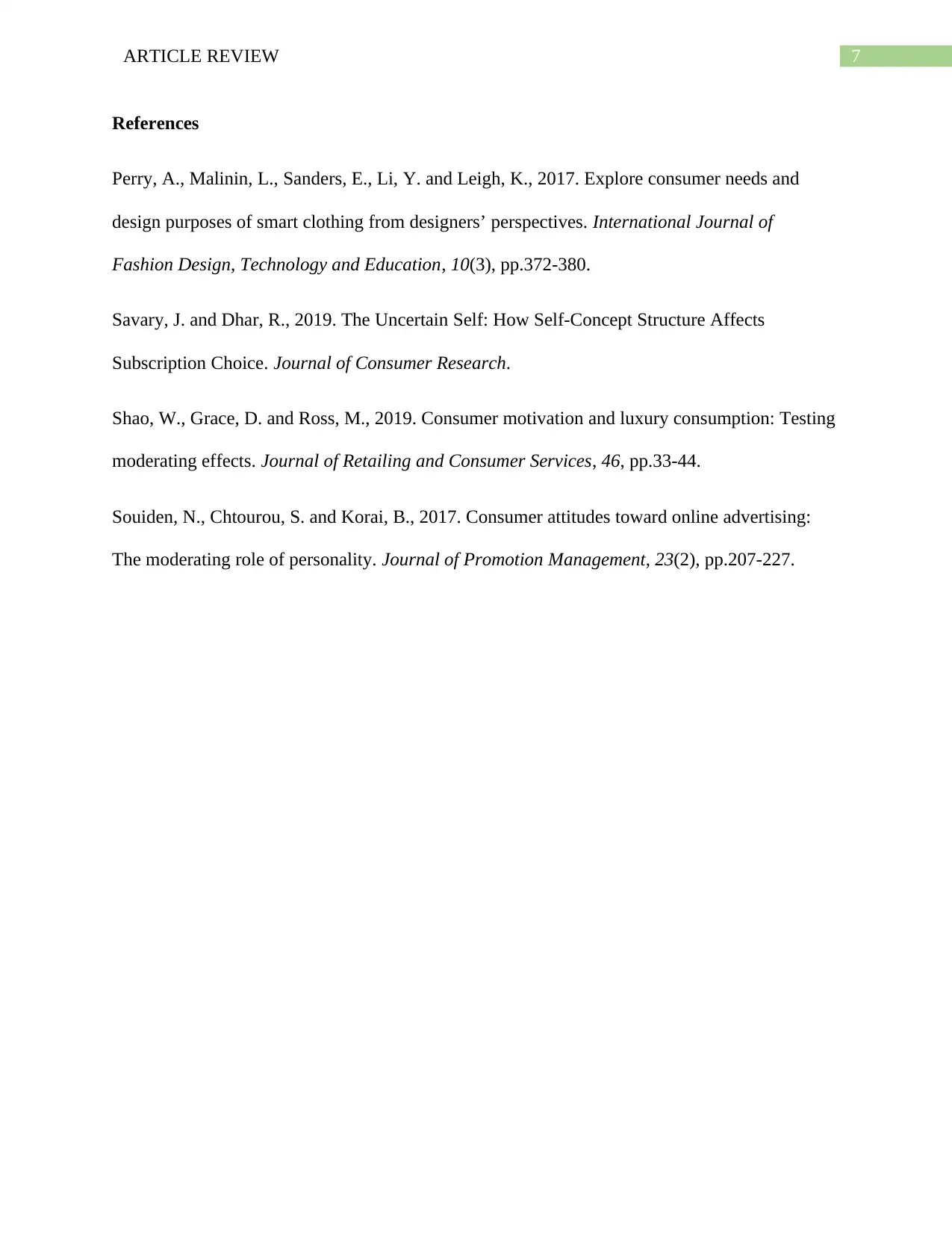
7ARTICLE REVIEW
References
Perry, A., Malinin, L., Sanders, E., Li, Y. and Leigh, K., 2017. Explore consumer needs and
design purposes of smart clothing from designers’ perspectives. International Journal of
Fashion Design, Technology and Education, 10(3), pp.372-380.
Savary, J. and Dhar, R., 2019. The Uncertain Self: How Self-Concept Structure Affects
Subscription Choice. Journal of Consumer Research.
Shao, W., Grace, D. and Ross, M., 2019. Consumer motivation and luxury consumption: Testing
moderating effects. Journal of Retailing and Consumer Services, 46, pp.33-44.
Souiden, N., Chtourou, S. and Korai, B., 2017. Consumer attitudes toward online advertising:
The moderating role of personality. Journal of Promotion Management, 23(2), pp.207-227.
References
Perry, A., Malinin, L., Sanders, E., Li, Y. and Leigh, K., 2017. Explore consumer needs and
design purposes of smart clothing from designers’ perspectives. International Journal of
Fashion Design, Technology and Education, 10(3), pp.372-380.
Savary, J. and Dhar, R., 2019. The Uncertain Self: How Self-Concept Structure Affects
Subscription Choice. Journal of Consumer Research.
Shao, W., Grace, D. and Ross, M., 2019. Consumer motivation and luxury consumption: Testing
moderating effects. Journal of Retailing and Consumer Services, 46, pp.33-44.
Souiden, N., Chtourou, S. and Korai, B., 2017. Consumer attitudes toward online advertising:
The moderating role of personality. Journal of Promotion Management, 23(2), pp.207-227.
1 out of 7
Related Documents
Your All-in-One AI-Powered Toolkit for Academic Success.
+13062052269
info@desklib.com
Available 24*7 on WhatsApp / Email
![[object Object]](/_next/static/media/star-bottom.7253800d.svg)
Unlock your academic potential
Copyright © 2020–2025 A2Z Services. All Rights Reserved. Developed and managed by ZUCOL.




